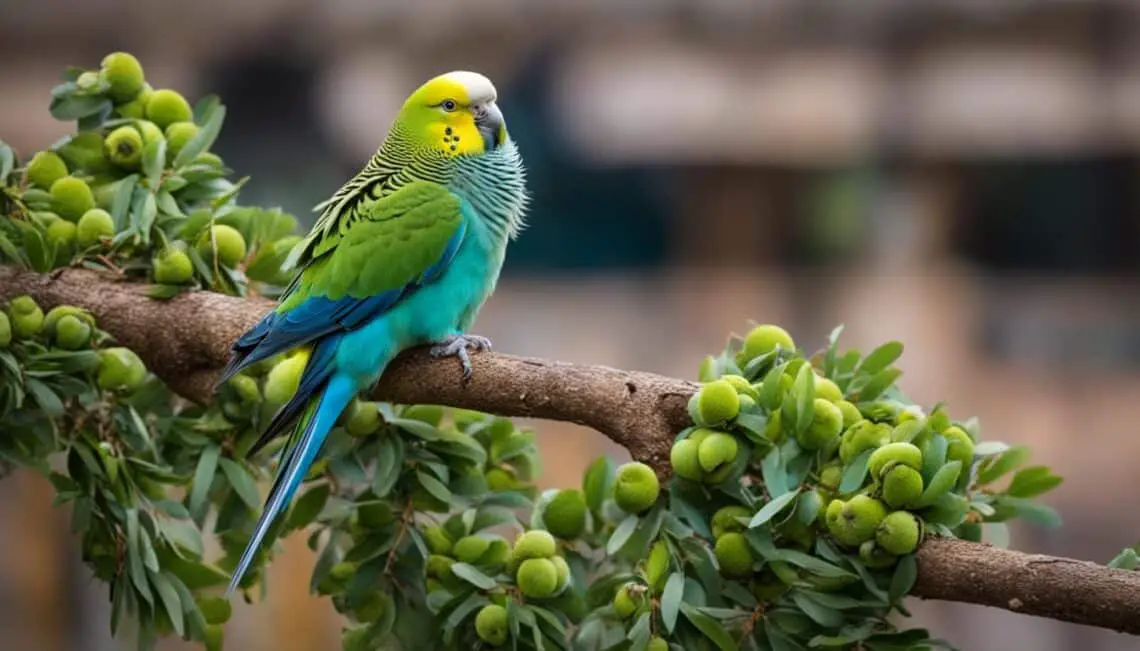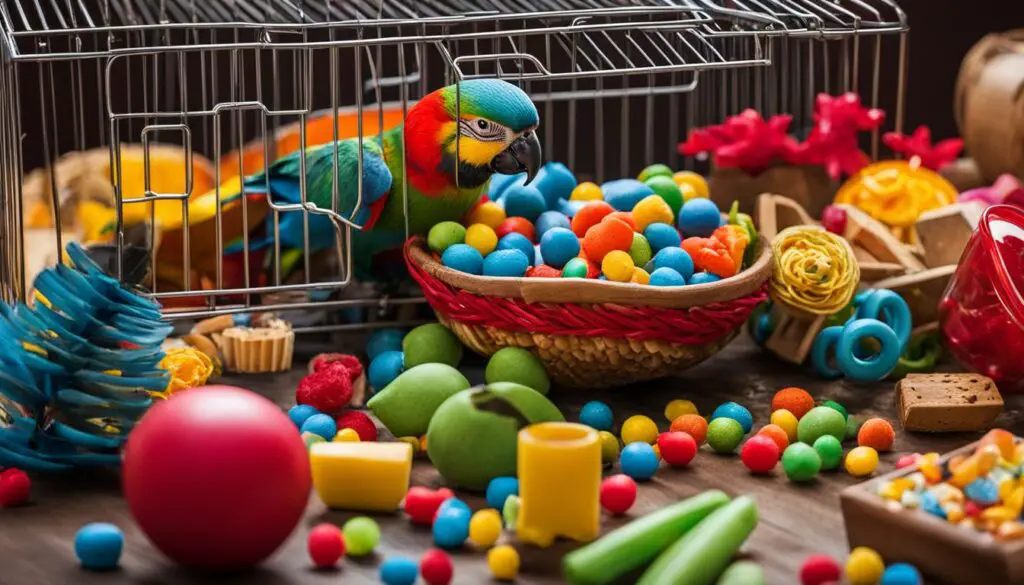As a parakeet owner, I understand the importance of ensuring my feathered friend’s well-being. Parakeets, like any living creatures, can experience anxiety, which can have a significant impact on their overall health and happiness. Recognizing the signs of anxiety in parakeets is crucial in providing them with the care they need.
Anxiety in parakeets can manifest in various ways, including stress bars on their feathers, feather picking or self-mutilation, aggression, loss of appetite, change in vocalization, repetitive behavior, fear, and boredom. These signs indicate that our beloved parakeets are not feeling their best and require our attention to help reduce their anxiety.
Key Takeaways
- Parakeets can experience anxiety, which affects their overall well-being.
- Signs of anxiety in parakeets include stress bars on feathers, aggression, and loss of appetite.
- Reducing anxiety in parakeets requires understanding their specific needs and implementing effective methods.
- An optimal environment, behavior modification techniques, and addressing the underlying causes can help reduce anxiety in parakeets.
- Consulting with avian specialists or behaviorists is essential for personalized guidance in reducing anxiety in parakeets.
Causes of Anxiety in Parakeets
Several factors can contribute to anxiety in parakeets. It is important to understand these causes in order to effectively reduce anxiety and promote the well-being of your feathered friend.
Hand Feeding
Hand feeding, a common practice in the pet industry, involves separating parakeets from their parents at a young age. While this method ensures that the birds are properly nourished, it can also be a traumatic experience for them. The sudden separation and the absence of their natural caretakers can lead to anxiety and stress.
Training Mishaps
The way we train our parakeets can also play a significant role in their anxiety levels. Inconsistent or improper training methods can cause confusion and frustration, ultimately leading to anxiety. It is vital to use positive reinforcement techniques and consistent training strategies to ensure a positive learning experience for your parakeet.
Nutritional Deficits
A balanced diet is crucial for a parakeet’s mental and physical health. Nutritional deficits, such as a lack of essential vitamins and nutrients, can contribute to anxiety and other behavioral problems. Providing a varied and nutritious diet that includes fresh fruits, vegetables, high-quality pellets, and occasional treats can help prevent nutritional deficiencies and promote overall well-being.
Environmental Changes
Parakeets are creatures of habit and thrive on routine. Any significant changes in their environment, such as moving to a new home or alterations in their daily routine, can cause stress and anxiety. It is essential to introduce changes gradually and provide a stable and predictable environment for your parakeet.
“Understanding the causes of anxiety empowers us to implement effective strategies to reduce stress and promote the well-being of our parakeets.”
The sequel follows with Section 3 exploring the creation of an optimal environment for parakeets, which includes meeting their specific needs and promoting physical and emotional well-being.
Creating an Optimal Environment for Parakeets
Creating an optimal environment is crucial for reducing anxiety in parakeets. To ensure their physical and emotional well-being, meeting their specific needs is essential. By providing the right conditions, you can help alleviate anxiety and promote a sense of security in your feathered friend.
Physiological Needs
Parakeets have specific physiological needs that must be met for their optimal husbandry. Proper nutrition is vital, so make sure to provide a balanced diet that includes a variety of fruits, vegetables, seeds, and pellets. Additionally, ensure they have access to fresh clean water at all times. Sufficient sleep is also important, so provide a quiet and dark sleeping area to help them get their rest. Regular exercise is essential for their physical well-being, so allow them enough space to fly and explore. Lastly, exposure to natural sunlight or full-spectrum UV lighting helps maintain their overall health.
Enrichment
Enrichment plays a significant role in parakeet care. These intelligent birds need mental stimulation to keep them engaged and prevent boredom-induced anxiety. Foraging is a natural behavior for parakeets, so consider providing opportunities for them to search for their food. This can be done by using foraging toys, hiding treats around their enclosure, or scattering their food in different areas. Problem-solving toys, such as puzzle feeders or treat-dispensing toys, also provide mental stimulation. It’s important to rotate and introduce new toys regularly to keep their interest piqued.
Socialization
Parakeets are highly social animals and thrive on interaction with their human caregivers. Spending quality time with your parakeet through gentle handling, talking, and playing helps stimulate their social needs. Provide a variety of perches and toys to encourage exploration and climbing. Consider setting up a play gym or designated area outside their cage where they can interact with you in a safe environment. Having multiple parakeets can also fulfill their socialization needs, but it’s crucial to ensure compatibility and provide adequate space for each bird.
Summary
Meeting the optimal parakeet husbandry requirements, including their physiological, enrichment, and social needs, is crucial for reducing anxiety in these beautiful birds. By providing the right nutrition, opportunities for mental stimulation, and adequate socialization, you can create a harmonious environment that promotes their physical and emotional well-being. Remember, a happy and content parakeet is a healthy parakeet.
Behavior Modification Techniques for Parakeets
When it comes to reducing anxiety-related behaviors in parakeets, behavior modification techniques can be highly effective. These strategies focus on reinforcing desirable behaviors and minimizing unwanted ones through positive reinforcement and redirection.
One key concept in behavior modification is positive reinforcement. By rewarding desired behaviors, such as calmness and contentment, while ignoring or redirecting unwanted behaviors, parakeets can learn to replace anxious behaviors with more positive ones. This approach helps create a more harmonious and stress-free environment for your feathered friend.
Another important aspect of behavior modification is understanding and reinforcing natural parakeet behaviors. Parakeets have innate behaviors, such as foraging, problem-solving, and communication, which are essential to their well-being. By providing opportunities for these natural behaviors, you can engage their minds and redirect their energy away from anxious behaviors.
Implementing behavior modification techniques requires understanding the ABC model: Antecedent, Behavior, and Consequence. This model helps identify the triggers or antecedents that lead to anxiety-related behaviors in parakeets. By addressing the antecedents and adjusting the environment accordingly, you can help prevent or minimize anxious responses.
Tip: Working with a reputable avian specialist or behaviorist can provide valuable guidance in developing a personalized behavior modification plan for your parakeet. They can help you identify specific triggers and design strategies to address them effectively.
Remember, behavior modification takes time and patience. Consistency and repetition are key to reinforcing desired behaviors and reducing unwanted ones. By partnering with your parakeet, you can create a closer bond as you navigate their behavior journey together.
Stay tuned for the next section, where we’ll explore the conclusion of our guide to reducing anxiety in parakeets and creating a harmonious environment for your feathered companion.
Conclusion
Reducing anxiety in parakeets is vital for their overall well-being and creating a harmonious environment. By understanding the causes of anxiety, implementing appropriate husbandry practices, and utilizing behavior modification techniques, you can effectively reduce anxiety in your parakeet and ensure its mental health. Taking a proactive approach to caring for your parakeet’s emotional needs will help it thrive and lead a happier, stress-free life.
Creating an optimal environment is key to parakeet well-being. Meeting their physiological, enrichment, and socialization needs is essential. Providing a well-balanced diet, ample rest, opportunities for physical exercise, and exposure to natural sunlight will contribute to their physical and emotional well-being. Enrichment activities like foraging, problem-solving, and having toys also help stimulate their minds and reduce anxiety. Lastly, parakeets are social animals, so regular interaction and attention from their human caregivers are crucial for their emotional health.
In addition to environmental considerations, behavior modification techniques can play a significant role in reducing anxiety-related behaviors in parakeets. Through positive reinforcement and redirecting unwanted behaviors, you can replace anxious behaviors with more positive ones. Understanding the triggers for anxiety-related behaviors and implementing appropriate modification techniques based on the ABC model (Antecedent, Behavior, Consequence) can help effectively manage and reduce anxiety in your parakeet.
Remember, while you can provide a loving and safe environment for your parakeet, it’s always beneficial to seek professional guidance from an avian specialist or behaviorist. They can provide personalized advice and support to ensure you are taking the right steps in reducing anxiety and promoting the overall well-being of your beloved parakeet.
FAQ
How can I recognize signs of anxiety in my parakeet?
Signs of anxiety in parakeets include stress bars on feathers, feather picking or self-mutilation, aggression, loss of appetite, change in vocalization, repetitive behavior, fear, and boredom.
What are some common causes of anxiety in parakeets?
Several factors can contribute to anxiety in parakeets, including hand feeding, training mishaps, nutritional deficits, and environmental changes.
How can I create an optimal environment for my parakeet?
Creating an optimal environment for parakeets includes meeting their physiological, enrichment, and psychological/social needs, such as providing proper nutrition, sufficient sleep, exercise, exposure to natural sunlight, stimulating activities, and socialization with their human caregivers.
What behavior modification techniques can be used to reduce anxiety in parakeets?
Behavior modification techniques for reducing anxiety in parakeets include positive reinforcement, identifying and reinforcing natural parakeet behaviors, and implementing the ABC model (Antecedent, Behavior, Consequence) to identify triggers and modify unwanted behaviors.
How important is it to reduce anxiety in parakeets?
Reducing anxiety in parakeets is crucial for their overall well-being and creating a harmonious environment. By addressing their specific needs and implementing effective strategies, you can help them thrive and lead a happier, stress-free life.






No Comments